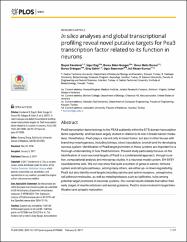| dc.contributor.author | Kandemir, Basak | |
| dc.contributor.author | Dag, Ugur | |
| dc.contributor.author | Bakir Gungor, Burcu | |
| dc.contributor.author | Durasi, Ilknur Melis | |
| dc.contributor.author | Erdogan, Burcu | |
| dc.contributor.author | Sahin, Eray | |
| dc.contributor.author | Sezerman, Ugur | |
| dc.contributor.author | Kurnaz Aksan, Isil | |
| dc.date.accessioned | 2019-07-05T09:54:38Z | |
| dc.date.available | 2019-07-05T09:54:38Z | |
| dc.date.issued | 2017 | en_US |
| dc.identifier.citation | PLOS ONE Volume: 12 Issue: 2 Article Number: e0170585 DOI: 10.1371/journal.pone.0170585 | en_US |
| dc.identifier.issn | 1932-6203 | |
| dc.identifier.other | PubMed ID: 28158215 | |
| dc.identifier.other | Accession Number: WOS:000396161700015 | |
| dc.identifier.other | DOI: 10.1371/journal.pone.0170585 | |
| dc.identifier.other | Article Number: e0170585 | |
| dc.identifier.uri | http://acikerisim.agu.edu.tr/xmlui/handle/20.500.12573/70 | |
| dc.description | Support was provided by TUBITAK BIDEB project grants to UD and BE; TUBITAK grants no 107S064 and 214Z278 to IK. The funders had no role in study design, data collection and analysis, decision to publish, or preparation of the manuscript. | en_US |
| dc.description.abstract | Pea3 transcription factor belongs to the PEA3 subfamily within the ETS domain transcription factor superfamily, and has been largely studied in relation to its role in breast cancer metastasis. Nonetheless, Pea3 plays a role not only in breast tumor, but also in other tissues with branching morphogenesis, including kidneys, blood vasculature, bronchi and the developing nervous system. Identification of Pea3 target promoters in these systems are important for a thorough understanding of how Pea3 functions. Present study particularly focuses on the identification of novel neuronal targets of Pea3 in a combinatorial approach, through curation, computational analysis and microarray studies in a neuronal model system, SH-SY5Y neuroblastoma cells. We not only show that quite a number of genes in cancer, immune system and cell cycle pathways, among many others, are either up- or down-regulated by Pea3, but also identify novel targets including ephrins and ephrin receptors, semaphorins, cell adhesion molecules, as well as metalloproteases such as kallikreins, to be among potential target promoters in neuronal systems. Our overall results indicate that rather than early stages of neurite extension and axonal guidance, Pea3 is more involved in target identification and synaptic maturation. | en_US |
| dc.description.sponsorship | TUBITAK BIDEB TUBITAK -107S064 / 214Z278 | en_US |
| dc.language.iso | eng | en_US |
| dc.publisher | PUBLIC LIBRARY SCIENCE, 1160 BATTERY STREET, STE 100, SAN FRANCISCO, CA 94111 USA | en_US |
| dc.relation.ispartofseries | PLOS ONE;Volume: 12 Issue: 2 | |
| dc.rights | info:eu-repo/semantics/openAccess | en_US |
| dc.subject | HIPPOCAMPAL-NEURONS | en_US |
| dc.subject | NEURITE OUTGROWTH | en_US |
| dc.subject | KINASE ACTIVATION | en_US |
| dc.subject | KINASE ACTIVATION | en_US |
| dc.subject | MOTOR-NEURONS | en_US |
| dc.subject | EPH RECEPTORS | en_US |
| dc.subject | C-JUN | en_US |
| dc.subject | ETS | en_US |
| dc.subject | EXPRESSION | en_US |
| dc.subject | PROTEIN | en_US |
| dc.title | In silico analyses and global transcriptional profiling reveal novel putative targets for Pea3 transcription factor related to its function in neurons | en_US |
| dc.type | article | en_US |
| dc.contributor.department | AGÜ, Mühendislik Fakültesi, Bilgisayar Mühendisliği Bölümü | en_US |
| dc.contributor.institutionauthor | | |
| dc.relation.publicationcategory | Makale - Uluslararası Hakemli Dergi - Kurum Öğretim Elemanı | en_US |


















